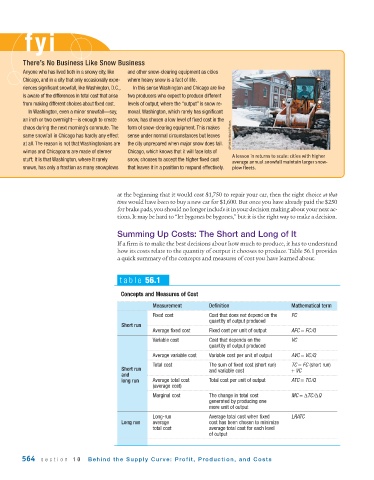Page 606 - Krugmans Economics for AP Text Book_Neat
P. 606
fyi
There’s No Business Like Snow Business
Anyone who has lived both in a snowy city, like and other snow-clearing equipment as cities
Chicago, and in a city that only occasionally expe- where heavy snow is a fact of life.
riences significant snowfall, like Washington, D.C., In this sense Washington and Chicago are like
is aware of the differences in total cost that arise two producers who expect to produce different
from making different choices about fixed cost. levels of output, where the “output” is snow re-
In Washington, even a minor snowfall—say, moval. Washington, which rarely has significant
an inch or two overnight—is enough to create snow, has chosen a low level of fixed cost in the
chaos during the next morning’s commute. The form of snow-clearing equipment. This makes
same snowfall in Chicago has hardly any effect sense under normal circumstances but leaves AP/Wide World Photos
at all. The reason is not that Washing tonians are the city unprepared when major snow does fall.
wimps and Chicagoans are made of sterner Chicago, which knows that it will face lots of
A lesson in returns to scale: cities with higher
stuff; it is that Washington, where it rarely snow, chooses to accept the higher fixed cost
average annual snowfall maintain larger snow-
snows, has only a fraction as many snowplows that leaves it in a position to respond effectively. plow fleets.
at the beginning that it would cost $1,750 to repair your car, then the right choice at that
time would have been to buy a new car for $1,600. But once you have already paid the $250
for brake pads, you should no longer include it in your decision making about your next ac-
tions. It may be hard to “let bygones be bygones,” but it is the right way to make a decision.
Summing Up Costs: The Short and Long of It
If a firm is to make the best decisions about how much to produce, it has to understand
how its costs relate to the quantity of output it chooses to produce. Table 56.1 provides
a quick summary of the concepts and measures of cost you have learned about.
table 56.1
Concepts and Measures of Cost
Measurement Definition Mathematical term
Fixed cost Cost that does not depend on the FC
quantity of output produced
Short run
Average fixed cost Fixed cost per unit of output AFC = FC/Q
Variable cost Cost that depends on the VC
quantity of output produced
Average variable cost Variable cost per unit of output AVC = VC/Q
Total cost The sum of fixed cost (short run) TC = FC (short run)
Short run and variable cost + VC
and
long run Average total cost Total cost per unit of output ATC = TC/Q
(average cost)
Marginal cost The change in total cost MC =ΔTC/ΔQ
generated by producing one
more unit of output
Long -run Average total cost when fixed LRATC
Long run average cost has been chosen to minimize
total cost average total cost for each level
of output
564 section 10 Behind the Supply Curve: Profit, Production, and Costs

